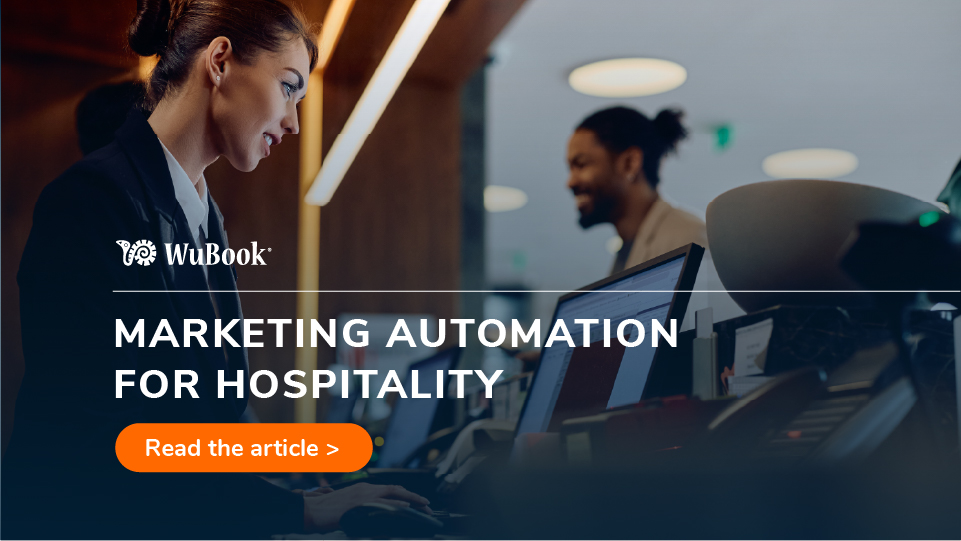Dear WuBookers, entrusting technology with essential but repetitive operations is an attractive prospect not only from a practical point of view, but also from an economic one. In fact, marketing automation allows you to increase your facility efficiency and improve the customer experience, with positive spin-offs for management, reputation, and – potentially – revenue.
Here’s how to leverage automation systems in hotels and how to integrate them within a communication and promotion strategy.
What is marketing automation
Doing marketing automation in hotels, as in any other type of business, means automating recurring activities related to communication and marketing, simplifying staff operations and optimizing the online user conversion path. Through specific software and platforms, it is possible to segment contacts into different audience categories, plan by the book the entire flow of messages that each audience should receive, and monitor the data of each action to evaluate the trend and intervene where necessary.
This at least is the more advanced situation that requires some organization and non-trivial investment.
However, there are solutions that make it possible to achieve a good degree of automation and still enjoy the benefits of this practice, especially in the hotel industry.

The benefits of automation
Imagine you are in the middle of the season, with tourists arriving and departing, reservations from multiple channels, and new requests to be handled. How convenient would it be to be able to rely on a system that relieves you, at least in part, of repetitive tasks such as guest messages? The main advantage of marketing automation is just that: it saves time for your facility staff, ensuring optimal customer service.
In fact, without this possibility, it is highly likely that the pre, during and post-stay interaction can make the difference in perceived quality and customer loyalty will be lost.
Automating does not mean giving up personalization, quite the contrary. By planning your messages in advance, you can anticipate your customers’ needs and prepare different types of communications on a case-by-case basis, varying as much as necessary to make them seem tailor-made. Planning the mailings, on the other hand, will ensure that they arrive at the right time to achieve the desired result. Let’s take a few examples to better understand the potential of these tools.
Examples of marketing automation for hotels
As you may already know, customer satisfaction also depends on how important we made them feel, that is, the degree of attention and care we gave them before, during and after their stay, including on the communication front.
It is precisely in these three moments that most of the automated actions are concentrated.
Before arrival
Prior to arrival at the property, it is advisable to remind the guest of their reservation details and useful information regarding the hotel and its services.
Any instructions regarding check-in can also be conveyed at this stage, thus streamlining staff operations.
An email, text message or even a message via WhatsApp are effective reminders that can reassure the customer and stimulate them to further purchases.
During the stay
A welcome message will make guests feel welcome and may contain practical hints or tips to enhance their hotel experience: from wi-fi passwords, to tourist attractions, to participating or nearby restaurants.
The length of stay can also be leveraged to suggest a rate upgrade or promote extra treatments and services, such as spa, pool or breakfast at the hotel, preferably at a special, reserved price.
Obviously, this should be calibrated to the actual length of stay (to avoid being harassing or pushy) and, especially in the case of sales promotions, preceded by an in-person communication that “warms up” to the offer.

After departure
After their stay is over, it is a good time to send a thank you and a request for a feedback, perhaps with some incentive such as a discount on your next reservation.
In this regard, the reason for the stay and, consequently, the type of guest should not be underestimated: if they are business travelers, for example, they are likely to have to return again in the future to do business or attend trade shows.
In these cases, it might be useful to point out the existence of any loyalty programs or send an email a few months down the road as a reminder of their experience at the property.
Zak for hotel marketing
So, marketing automation offers several advantages and can be easily integrated within a more or less structured promotional strategy. But how to incorporate this into your daily practices and with what tools?
As we have anticipated, there are ad-hoc programs that manage even quite complex streams of marketing automation across multiple channels, but to get started all you need is a good hotel management system, such as Zak, the PMS for hotels from WuBook.
Zak’s marketing automation features
Designed for hotels, B&Bs and vacation rentals, Zak fulfills all the most advanced functions of management software while also combining essential hospitality automations.
Through WuBook’s PMS, you can:
- create unlimited communication templates that are customizable in all forms: from texts (even in multiple languages), to graphics (including logos and attachments), to offer details. To facilitate the creation of texts, moreover, templates are integrated with ChatGPT for automatic generation of messages and multilingual translations;
- save and use the templates as often as desired for communications via SMS, WhatsApp and email;
- leverage the internal CRM to derive specific information about acquired and potential customers, mark them (e.g., distinguishing between “arrived” and “left”), and study the communication and marketing strategy most in line with each target;
- automate the sending of emails according to different parameters, such as the channel of origin (setting sending rules only for those who arrive or do not arrive from OTAs, for example) or the time factor (all bookings received by/until a certain date receive a certain template) and so on.
In addition, thanks to the email history stored in the platform, it is always possible to trace the communications sent (or not) for each customer and have an overview of the operations performed and the results achieved.

Why use Zak for automation
While Zak is not a program born for automation, it offers the opportunity to use some of the typical features of ad-hoc software with different benefits.
The first concerns costs: smaller realities or those who want to start trying their hand at automated communications can do so without immediately investing in specific and often costly programs.
It then results in an operational optimization, since all operations can be handled from the same platform, without having to switch from one system to another.
Complex systems also require a rather high level of technical expertise, which – if not well designed and governed – risks losing control over the communications sent, while simpler software also ensures greater freedom of customization and modification.
In summary, marketing automation is certainly useful and promising but, to avoid it turning into a technological trap, it is important to choose tools commensurate with one’s structure and needs.
